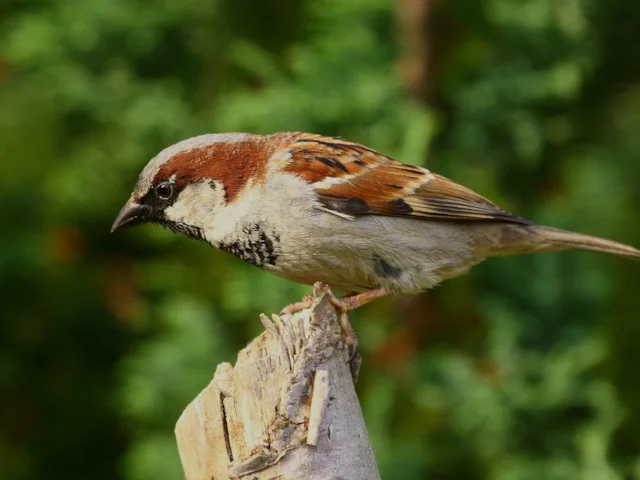Big Garden Birdwatch gives clues to House Sparrow decline
fc95aebf-1d9f-46e7-8782-fa19e6628881

Our understanding of the rapid fall in numbers of one of Britain's most loved birds is being helped by contributions to the Big Garden Birdwatch (BGBW).
The BGBW is the nation's most popular bird survey, but apart from being fun to take part in, the annual 'citizen science' survey really does contribute the deeper knowledge of Britain's birds. Data collected from the survey is helping to track the decline of House Sparrow and suggest possible reasons for its fall in status.
House Sparrow is now ensconced on the Birds of Conservation Concern Red List due to the sharp downward trend in numbers. However, and interesting facet of this population plummet is that the declines are generally greater in urban than rural areas, and in eastern and south-eastern Britain – the population is either stable or increasing in other parts of the country. BGBW data is one of the most important evidence strands being used to investigate the sparrow situation, along with figures from the Nest Record Scheme (NRS) and Breeding Bird Survey.
A good indicator of the decline and the causes that underpin it is to assess breeding performance over time and area. The number of nestlings produced per nest (that is, productivity) during the time span of the available data was highest in Wales and lowest in eastern England though there was no difference between adjacent rural and urban areas. NRS data revealed that House sparrow clutch and brood size were indeed lower in the east than in the west, though the number of nesting attempts and the survival of fledglings differed little between the regions. BGBW data helps expand the limits of the figures collected by the more specialised NRS project.
This suggests that large scale influences such as climatic processes are responsible for the decline, along with more local habitat changes. As both nearby rural and urban populations appear to be responding to these in the same way, habitat changes appear not to be directly responsible, but food availability may be a factor in common with both.
In essence we are now almost sure that it its regional breeding success that is affecting the numbers of House Sparrow, and the causes are perhaps closer to being identified using data from the popular nationwide surveys.
The British Trust for Ornithology hope to establish standard measures to help with the comparison of further survey data, to help understand the varying annual regional population trends in productivity. In this way, the mystery of the fall of House Sparrow may yet be solved in time to halt its decline.
Reference
Morrison, C A , Robinson, R A , Leech, D I , Dadam, D, and Toms, M. 2014. Using citizen science to investigate the role of productivity in House Sparrow Passer domesticus population trends. Bird Study: doi: 10.1080/00063657.2013.874975.
The BGBW is the nation's most popular bird survey, but apart from being fun to take part in, the annual 'citizen science' survey really does contribute the deeper knowledge of Britain's birds. Data collected from the survey is helping to track the decline of House Sparrow and suggest possible reasons for its fall in status.
House Sparrow is now ensconced on the Birds of Conservation Concern Red List due to the sharp downward trend in numbers. However, and interesting facet of this population plummet is that the declines are generally greater in urban than rural areas, and in eastern and south-eastern Britain – the population is either stable or increasing in other parts of the country. BGBW data is one of the most important evidence strands being used to investigate the sparrow situation, along with figures from the Nest Record Scheme (NRS) and Breeding Bird Survey.
A good indicator of the decline and the causes that underpin it is to assess breeding performance over time and area. The number of nestlings produced per nest (that is, productivity) during the time span of the available data was highest in Wales and lowest in eastern England though there was no difference between adjacent rural and urban areas. NRS data revealed that House sparrow clutch and brood size were indeed lower in the east than in the west, though the number of nesting attempts and the survival of fledglings differed little between the regions. BGBW data helps expand the limits of the figures collected by the more specialised NRS project.
This suggests that large scale influences such as climatic processes are responsible for the decline, along with more local habitat changes. As both nearby rural and urban populations appear to be responding to these in the same way, habitat changes appear not to be directly responsible, but food availability may be a factor in common with both.
In essence we are now almost sure that it its regional breeding success that is affecting the numbers of House Sparrow, and the causes are perhaps closer to being identified using data from the popular nationwide surveys.
The British Trust for Ornithology hope to establish standard measures to help with the comparison of further survey data, to help understand the varying annual regional population trends in productivity. In this way, the mystery of the fall of House Sparrow may yet be solved in time to halt its decline.
Reference
Morrison, C A , Robinson, R A , Leech, D I , Dadam, D, and Toms, M. 2014. Using citizen science to investigate the role of productivity in House Sparrow Passer domesticus population trends. Bird Study: doi: 10.1080/00063657.2013.874975.

